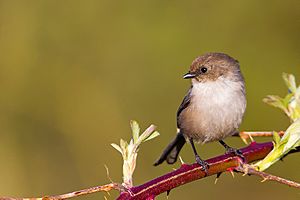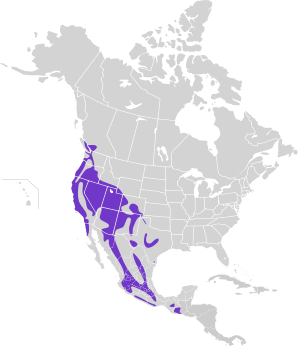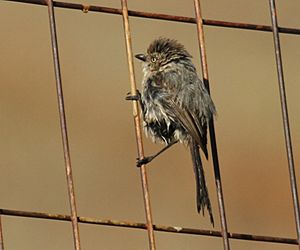American bushtit facts for kids
Quick facts for kids American bushtit |
|
|---|---|
 |
|
| In Chilliwack, British Columbia, Canada | |
| Conservation status | |
| Scientific classification | |
| Genus: |
Psaltriparus
|
| Species: |
minimus
|
 |
|
The American bushtit (Psaltriparus minimus) is a tiny, active bird. It is the only bird of its family, Aegithalidae, found in the New World. It is also the only member of its genus, Psaltriparus. In North America, people often just call it "bushtit."
Contents
Discover the American Bushtit
The American bushtit is a very small passerine bird. Passerine birds are often called "perching birds." This bird is about 11 centimeters (4.3 inches) long. It weighs only about 5 to 6 grams (0.18 to 0.21 ounces).
What Does It Look Like?
This bird is mostly gray-brown. It has a large head and a short neck. Its tail is long, and its bill is short and stubby. Male bushtits have dark eyes. Adult female bushtits have yellow eyes.
Some bushtits living near the coast have a brown "cap" on their heads. Those living inland have a brown "mask" around their eyes.
Where Do They Live?
American bushtits live in open woodlands. These woods often have oak trees and scrubby chaparral plants. You can also find them in parks and gardens. They live all year in the western United States and highland parts of Mexico. Their home range stretches from Vancouver in Canada, through the Great Basin, and down to southern Mexico and Guatemala.
How Do They Behave?
American bushtits are very active and social birds. They often fly around in large groups. These groups can have 10 to over 40 birds. They look for small insects and spiders to eat.
They often join other bird species in these groups. You might see them with chickadees and warblers. Members of the group constantly make contact calls. These calls sound like a short "spit."
Building a Home
This bird builds a very special pendant nest. It hangs down like a bag. They make it from moss and lichen. They use spider silk to hold it all together. Then, they line the inside with soft feathers.
Black-eared Bushtit: A Color Variation
There is a type of bushtit that used to be called the "black-eared" bushtit (P. melanotis). It was once thought to be a separate species. You can tell it apart by its dark patch near its ear. This dark patch is called an auricular.
Where to Find Black-eared Bushtits
This dark ear patch is not seen in the northern parts of the American bushtit's home. It first appears near the Mexican border, especially in Texas. Most young males in that area have the black ear patch. Adult females usually do not. Some birds might only have a few dark lines on their face instead of a full patch.
As you go further south into Mexico, the black-eared form becomes more common. In central Mexico and further south, almost all males have a full black ear patch. Even adult females often have a black arc over their eye and a black line through it. This is an example of polymorphism, which means different forms or colors within the same species.
Gallery
The nest of the American bushtit:
Images for kids
See also
 In Spanish: Mito sastrecillo para niños
In Spanish: Mito sastrecillo para niños







